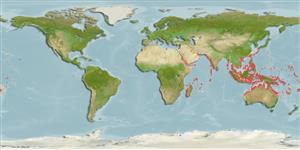Environment: milieu / climate zone / depth range / distribution range
Écologie
marin récifal; profondeur 2 - 25 m (Ref. 48637). Tropical; 31°N - 31°S, 31°E - 169°W
Indo-West Pacific: Persian Gulf (Ref.80050); Red Sea to Samoa, north to the Ryukyu Islands, south to the Great Barrier Reef. The exact range is uncertain because of confusion of this species with Sphyraena obtusata (Ref. 9768). Mediterranean: Lessepsian migrant (Ref. 50345).
Length at first maturity / Taille / Poids / Âge
Maturity: Lm 28.0 range ? - ? cm
Max length : 60.0 cm TL mâle / non sexé; (Ref. 9768); common length : 40.0 cm TL mâle / non sexé; (Ref. 9768)
Épines dorsales (Total): 6; Rayons mous dorsaux (Total): 9; Épines anales 2; Rayons mous anaux: 9. Body with two brown or brownish yellow longitudinal stripes which may disappear in old specimens; caudal fin yellowish (Ref. 9768). S. flavicauda is more elongate than S. obtusata and differs in dorsal fin height pectoral fin length (Ref. 37816).
Inhabits lagoon and sheltered seaward reefs (Ref. 9710); also found in bays (Ref. 9768). Often schools on coastal reefs (Ref. 48637).
Life cycle and mating behavior
Maturité | Reproduction | Frai | Œufs | Fécondité | Larves
Randall, J.E., G.R. Allen and R.C. Steene, 1990. Fishes of the Great Barrier Reef and Coral Sea. University of Hawaii Press, Honolulu, Hawaii. 506 p. (Ref. 2334)
Statut dans la liste rouge de l'IUCN (Ref. 130435)
Menace pour l'homme
Harmless
Utilisations par l'homme
Pêcheries: commercial
Plus d'informations
RéférencesAquacultureProfil d'aquacultureSouchesGénétiqueElectrophoresesHéritabilitéPathologiesTraitementNutrientsMass conversion
Outils
Articles particuliers
Télécharger en XML
Sources Internet
Estimates based on models
Preferred temperature (Ref.
123201): 24.3 - 29.3, mean 28.4 °C (based on 3668 cells).
Phylogenetic diversity index (Ref.
82804): PD
50 = 0.5000 [Uniqueness, from 0.5 = low to 2.0 = high].
Bayesian length-weight: a=0.00794 (0.00523 - 0.01205), b=2.89 (2.77 - 3.01), in cm total length, based on LWR estimates for this species & Genus-body shape (Ref.
93245).
Niveau trophique (Ref.
69278): 3.9 ±0.64 se; based on food items.
Generation time: 3.7 ( na - na) years. Estimated as median ln(3)/K based on 2
growth studies.
Résilience (Ref.
120179): Milieu, temps minimum de doublement de population : 1,4 à 4,4 années (Preliminary K or Fecundity.).
Fishing Vulnerability (Ref.
59153): Low to moderate vulnerability (33 of 100).
Nutrients (Ref.
124155): Calcium = 23.7 [11.4, 65.2] mg/100g; Iron = 0.349 [0.160, 0.757] mg/100g; Protein = 20 [18, 22] %; Omega3 = 0.0786 [, ] g/100g; Selenium = 29 [12, 77] μg/100g; VitaminA = 42.8 [9.1, 220.2] μg/100g; Zinc = 0.572 [0.351, 0.999] mg/100g (wet weight);
